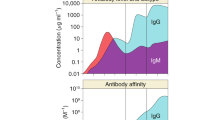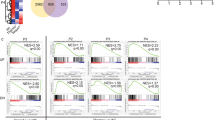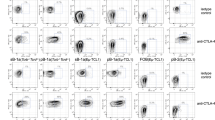Abstract
The positive and negative selection of lymphocytes by antigen is central to adaptive immunity and self-tolerance, yet how this is determined by different antigens is not completely understood. We found that thymocyte-selection-associated family member 2 (Themis2) increased the positive selection of B1 cells and germinal center B cells by self and foreign antigens. Themis2 lowered the threshold for B–cell activation by low-avidity, but not high-avidity, antigens. Themis2 constitutively bound the adaptor protein Grb2, src-kinase Lyn and signal transducer phospholipase γ2 (PLC-γ2), and increased activation of PLC-γ2 and its downstream pathways following B cell receptor stimulation. Our findings identify a unique function for Themis2 in differential signaling and provide insight into how B cells discriminate between antigens of different quantity and quality.
This is a preview of subscription content, access via your institution
Access options
Subscribe to this journal
Receive 12 print issues and online access
$209.00 per year
only $17.42 per issue
Buy this article
- Purchase on Springer Link
- Instant access to full article PDF
Prices may be subject to local taxes which are calculated during checkout







Similar content being viewed by others
References
Goodnow, C.C., Sprent, J., Fazekas de St Groth, B., Vinuesa, C.G. & Vinuesa, C.G. Cellular and genetic mechanisms of self tolerance and autoimmunity. Nature 435, 590–597 (2005).
Hardy, R.R. B-1 B cell development. J. Immunol. 177, 2749–2754 (2006).
Dintzis, R.Z., Okajima, M., Middleton, M.H., Greene, G. & Dintzis, H.M. The immunogenicity of soluble haptenated polymers is determined by molecular mass and hapten valence. J. Immunol. 143, 1239–1244 (1989).
Sabouri, Z. et al. Redemption of autoantibodies on anergic B cells by variable-region glycosylation and mutation away from self-reactivity. Proc. Natl. Acad. Sci. USA 111, E2567–E2575 (2014).
Roozendaal, R. et al. Conduits mediate transport of low-molecular-weight antigen to lymph node follicles. Immunity 30, 264–276 (2009).
Batista, F.D. & Harwood, N.E. The who, how and where of antigen presentation to B cells. Nat. Rev. Immunol. 9, 15–27 (2009).
Peirce, M.J. et al. Themis2/ICB1 is a signaling scaffold that selectively regulates macrophage Toll-like receptor signaling and cytokine production. PLoS One 5, e11465 (2010).
Johnson, A.L. et al. Themis is a member of a new metazoan gene family and is required for the completion of thymocyte positive selection. Nat. Immunol. 10, 831–839 (2009).
Lesourne, R. et al. Themis, a T cell-specific protein important for late thymocyte development. Nat. Immunol. 10, 840–847 (2009).
Fu, G. et al. Themis controls thymocyte selection through regulation of T cell antigen receptor-mediated signaling. Nat. Immunol. 10, 848–856 (2009).
Patrick, M.S. et al. Gasp, a Grb2-associating protein, is critical for positive selection of thymocytes. Proc. Natl. Acad. Sci. USA 106, 16345–16350 (2009).
Kakugawa, K. et al. A novel gene essential for the development of single positive thymocytes. Mol. Cell. Biol. 29, 5128–5135 (2009).
Brockmeyer, C. et al. T cell receptor (TCR)-induced tyrosine phosphorylation dynamics identifies THEMIS as a new TCR signalosome component. J. Biol. Chem. 286, 7535–7547 (2011).
Paster, W. et al. GRB2-mediated recruitment of THEMIS to LAT is essential for thymocyte development. J. Immunol. 190, 3749–3756 (2013).
Lesourne, R. et al. Interchangeability of Themis1 and Themis2 in thymocyte development reveals two related proteins with conserved molecular function. J. Immunol. 189, 1154–1161 (2012).
Zvezdova, E. et al. Themis1 enhances T cell receptor signaling during thymocyte development by promoting Vav1 activity and Grb2 stability. Sci. Signal. 9, ra51–ra51 (2016).
Fu, G. et al. Themis sets the signal threshold for positive and negative selection in T-cell development. Nature 504, 441–445 (2013).
Cornall, R.J. et al. Polygenic autoimmune traits: Lyn, CD22, and SHP-1 are limiting elements of a biochemical pathway regulating BCR signaling and selection. Immunity 8, 497–508 (1998).
Goodnow, C.C. et al. Altered immunoglobulin expression and functional silencing of self-reactive B lymphocytes in transgenic mice. Nature 334, 676–682 (1988).
Hartley, S.B. et al. Elimination from peripheral lymphoid tissues of self-reactive B lymphocytes recognizing membrane-bound antigens. Nature 353, 765–769 (1991).
Ferry, H., Jones, M., Vaux, D.J., Roberts, I.S.D. & Cornall, R.J. The cellular location of self-antigen determines the positive and negative selection of autoreactive B cells. J. Exp. Med. 198, 1415–1425 (2003).
Fischer, M.B. et al. Dependence of germinal center B cells on expression of CD21/CD35 for survival. Science 280, 582–585 (1998).
Paus, D. et al. Antigen recognition strength regulates the choice between extrafollicular plasma cell and germinal center B cell differentiation. J. Exp. Med. 203, 1081–1091 (2006).
Genot, E. & Cantrell, D.A. Ras regulation and function in lymphocytes. Curr. Opin. Immunol. 12, 289–294 (2000).
Paster, W. et al. A THEMIS:SHP1 complex promotes T-cell survival. EMBO J. 34, 393–409 (2015).
Chen, Z. et al. Signalling thresholds and negative B-cell selection in acute lymphoblastic leukaemia. Nature 521, 357–361 (2015).
Dance, M., Montagner, A., Salles, J.-P., Yart, A. & Raynal, P. The molecular functions of Shp2 in the Ras/Mitogen-activated protein kinase (ERK1/2) pathway. Cell. Signal. 20, 453–459 (2008).
Ozdener, F., Dangelmaier, C., Ashby, B., Kunapuli, S.P. & Daniel, J.L. Activation of phospholipase Cgamma2 by tyrosine phosphorylation. Mol. Pharmacol. 62, 672–679 (2002).
Quek, L.S. et al. Fyn and Lyn phosphorylate the Fc receptor gamma chain downstream of glycoprotein VI in murine platelets, and Lyn regulates a novel feedback pathway. Blood 96, 4246–4253 (2000).
Shiow, L.R. et al. CD69 acts downstream of interferon-α/β to inhibit S1P1 and lymphocyte egress from lymphoid organs. Nature 440, 540–544 (2006).
Hartweger, H. et al. Themis2 is not required for B cell development, activation, and antibody responses. J. Immunol. 193, 700–707 (2014).
Cyster, J.G. & Goodnow, C.C. Protein tyrosine phosphatase 1C negatively regulates antigen receptor signaling in B lymphocytes and determines thresholds for negative selection. Immunity 2, 13–24 (1995).
Maroun, C.R., Naujokas, M.A., Holgado-Madruga, M., Wong, A.J. & Park, M. The tyrosine phosphatase SHP-2 is required for sustained activation of extracellular signal-regulated kinase and epithelial morphogenesis downstream from the met receptor tyrosine kinase. Mol. Cell. Biol. 20, 8513–8525 (2000).
Mor, A. & Philips, M.R. Compartmentalized Ras/MAPK signaling. Annu. Rev. Immunol. 24, 771–800 (2006).
Liu, Q. et al. CAPRI and RASAL impose different modes of information processing on Ras due to contrasting temporal filtering of Ca2+. J. Cell Biol. 170, 183–190 (2005).
Daniels, M.A. et al. Thymic selection threshold defined by compartmentalization of Ras/MAPK signaling. Nature 444, 724–729 (2006).
Acknowledgements
We thank the staff of Biomedical Services Unit, Oxford University for animal care and R. Brink (Garvan Institute) for HEL constructs. This work was supported by the Medical Research Council, Intramural Research Program of the Eunice Kennedy Shriver, NICHD (PEL: project number 1ZIAHD001803-19) and the Wellcome Trust (studentship to D.C.).
Author information
Authors and Affiliations
Contributions
D.C., M.D.-L., S.C., E.Z., C.A., P.E.L. and R.J.C. designed the research. D.C., M.D.-L., S.C., E.Z., R.L., S.U., D.B., S.C.B., K.R.B., T.L.C., H.F., C.W., M.M., A.G.d.P. and C.A. performed and analyzed the experiments. P.E.L. and R.J.C. supervised the project. M.D.-L., D.C., P.E.L. and R.J.C. wrote the manuscript.
Corresponding authors
Ethics declarations
Competing interests
The authors declare no competing financial interests.
Integrated supplementary information
Supplementary Figure 1 Complete deletion of Themis2 protein in Themis2 exon 4 knockouts.
(a) Amino acid sequence of Themis2, indicating splice junctions (black triangles) and the location of twelve high-scoring peptides identified by LC-MS/MS (highlighted in red). (b) The sequence, mass and location of the twelve peptides analyzed in wild-type (WT1) and Themis2 exon 4 knockout mice (KO1 and 2) mice, showing the sequencing result and scored intensity of MS/MS detection for each peptide.
Supplementary Figure 2 Themis2 does not affect B cell development but has a cell intrinsic effect on IgM BCR expression.
(a) Number of B cells in wild-type (WT) and Themis2-/- mice, gated on pro/pre (B220+CD43+), immature (B220+CD43-) and mature (B220++CD43-) B cells in the BM; and B1 (FSChighB220lowIgM++) B cells in the peritoneum, including B1a (CD5+) and B1b (CD5-) subsets. Columns show means and s.e.m. (b) The relative proportion of B cell subsets in lethally irradiated mice reconstituted for 8 weeks with 50:50 mixtures of wild-type or Themis2-/- CD45.2 and wildtype CD45.1 BM (gated as in Fig 2). Filled columns show mean percentage CD45.2+ cells and s.e.m., and data are representative of 3 experiments. (c) The mean IgM expression on mature (B220+IgD+) CD45.1 WT and CD45.2 Themis2-/- B cells in chimeric BM, spleen and mesenteric lymph node (MLN). Bars show means and s.e.m..
Supplementary Figure 3 Themis1 and Themis2 have non-overlapping and non-redundant functions.
(a) Flow cytometry of thymic and splenic lymphocytes from adult wild-type (WT), Themis1-/-, Themis2-/- and Themis1-/-Themis2-/- mice, illustrating the frequency of T cell subsets. Histograms are representative of 5 or more animals. (b-c) Number of cells in major T cell subsets in the thymus (b) and number of B cells in the spleens (c) of wild-type, Themis1-/-, Themis2-/- and Themis1-/-Themis2-/- mice. Bars show means and s.e.m. and comparison by unpaired t test, *P<0.05, **P<0.01 and ***P<0.001. (d) IgM expression on mature B220+IgD+ B cells in BM and spleens of WT, Themis1-/-, Themis2-/- and Themis1-/-Themis2-/- mice. Bars show means and s.e.m. and comparison by unpaired t test, *P<0.05 and **P<0.01.
Supplementary Figure 4 Themis2 is not limiting in the antibody response to NP-Ficoll and NP19-CGG.
(a) IgM and IgG3 anti-NP antibody titers in wild-type (WT) and Themis2-/- mice immunized with the T-independent antigen 4-hydroxy-3-nitrophenylacetyl (NP)-Ficoll. Symbols represent individual mice, and bars means and s.e.m.. (b) IgG1 anti-NP4 and anti-NP25 antibody titres in WT and Themis2-/- mice 7 and 14 days after primary immunization with the T-dependent antigen NP19-chicken γ-globulin (NP19-CGG) and at 44 days, 5 days after boosting with NP19-CGG. Symbols represent individual mice, bars means and s.e.m..
Supplementary Figure 5 Themis2 is not required for negative selection by self-antigen.
(a) Flow cytometry of B220+ lymphocytes from BM (left) and spleen (right) of IgHEL single and IgHEL/sHEL double transgenic mice, showing frequencies of B cell subsets and the typical IgD+IgMlo appearance of anergic IgHEL B cells in the presence of self-antigen. Data are representative of 5 mice. (b) Numbers of B220+ HEL-binding B cells in the bone marrow, spleen and MLN of wild-type and Themis2-/- IgHEL and IgHEL/sHEL transgenic mice. (c) Numbers of B cell subsets in wild-type and Themis2-/- IgHEL and IgHEL/mHEL double transgenic mice. Gating was on pro/pre (B220+CD24+CD43+), immature (B220+CD24++CD43-) and mature (B220++CD24+CD43-) B cells in BM and total B cells (B220+) in the spleen and MLN. Symbols represent individual mice, bars means and s.e.m.
Supplementary Figure 6 Themis2 supports the positive selection of germinal center B cells and determines the threshold for activation by membrane bound antigen.
(a) CD45.1 wild-type and CD45.2 wild-type or Themis2-/- IgHEL B cells were transferred into B6 mice 1 day before IP immunization with SRBCs conjugated to HEL. Percentage of wild-type and Themis2-/- CD45.2 IgHEL B cells at input and 8 days after immunization with SRBC-HEL, where columns show means and s.e.m. and comparison by unpaired t test, **P<0.01. Symbols represent individual mice at 8 days or the separate input samples. Data were combined from 3 experiments. (b) Scheme illustrating the approach to test the activation of WT and Themis2-/- IgHEL B cells by membrane bound antigens of varying affinity and abundance. pBMN retrovirus expressing mHEL variants linked to 3 tandem intracellular GFP molecules was stably transfected into NIH3T3 cells with or without an ICAM-1 construct and incubated overnight with CD45.2 and CD45.1 allotype-marked WT:WT or WT:Themis2-/- IgHEL B cells. (c) Percentage of IgHEL B cells activated by overnight incubation with NIH3T3 cell clones expressing a constant level of ICAM-1 and different levels of mHEL (2 clones), and variants mHEL2X and mHEL3X (2 clones each). Data are representative of three separate experiments with different clones. Symbols represent individual samples and bars means.
Supplementary Figure 7 Themis2 is critical for B cell activation with soluble HEL and associates with PLCγ2 independently of Grb2 binding.
(a) Mean B cell phosphospecific antibody binding to p38 and pAKT, after stimulation of mixed Themis2-/- and wild-type IgHEL B cells for 5 min with sHEL. (b) pERK activation following Themis2-/- and wild-type IgHEL B cell stimulation with indicated concentrations of anti-IgM F(ab’)2, showing a dose-response curve following 5 min incubations (top) and time-course (bottom). (c) Time course of mean phospho-specific antibody binding to pPLCγ2, after stimulation of Themis2-/- and wild-type IgHEL B cells with 100ng/ml sHEL or 10μg/ml anti-IgM F(ab’)2. In all experiments, MACS sorted IgHEL CD45.1 Themis2-/- and CD45.2 WT IgHEL B cells were co-cultured in triplicate and mean fluorescence levels evaluated by flow cytometry. Symbols show means (wild-type filled circles and Themis2-/- open circles) with bars 95% confidence limits and unpaired t tests *P<0.05 and **P <0.01. Each graph is representative of at least 3 independent experiments. (d) Anti-Myc and anti-FLAG stained western blot (WB) of crude extract and anti-FLAG immunoprecipitates (IPs) from HEK 293 cells expressing combinations of Myc-tagged Grb2, Flag-tagged Themis2 and FLAG-tagged Themis2-dPRR, which lacks the Grb2 binding site. (e) Anti-Themis2 and anti-FLAG stained WB of anti-Themis2 and anti-PLCγ2 IP from HEK 293 cells expressing combinations of Flag-tagged PLCγ2, Flag-tagged Themis2, and Flag-tagged Themis2-dPRR.
Supplementary information
Supplementary Text and Figures
Supplementary Figures 1–7 (PDF 1574 kb)
Rights and permissions
About this article
Cite this article
Cheng, D., Deobagkar-Lele, M., Zvezdova, E. et al. Themis2 lowers the threshold for B cell activation during positive selection. Nat Immunol 18, 205–213 (2017). https://doi.org/10.1038/ni.3642
Received:
Accepted:
Published:
Issue Date:
DOI: https://doi.org/10.1038/ni.3642
This article is cited by
-
Themis2 regulates natural killer cell memory function and formation
Nature Communications (2023)
-
Novel function of THEMIS2 in the enhancement of cancer stemness and chemoresistance by releasing PTP1B from MET
Oncogene (2022)
-
Src Family Protein Kinase Controls the Fate of B Cells in Autoimmune Diseases
Inflammation (2021)
-
Interferon γ induced compositional changes in human bone marrow derived mesenchymal stem/stromal cells
Clinical Proteomics (2017)
-
Themis2: setting the threshold for B-cell selection
Cellular & Molecular Immunology (2017)



